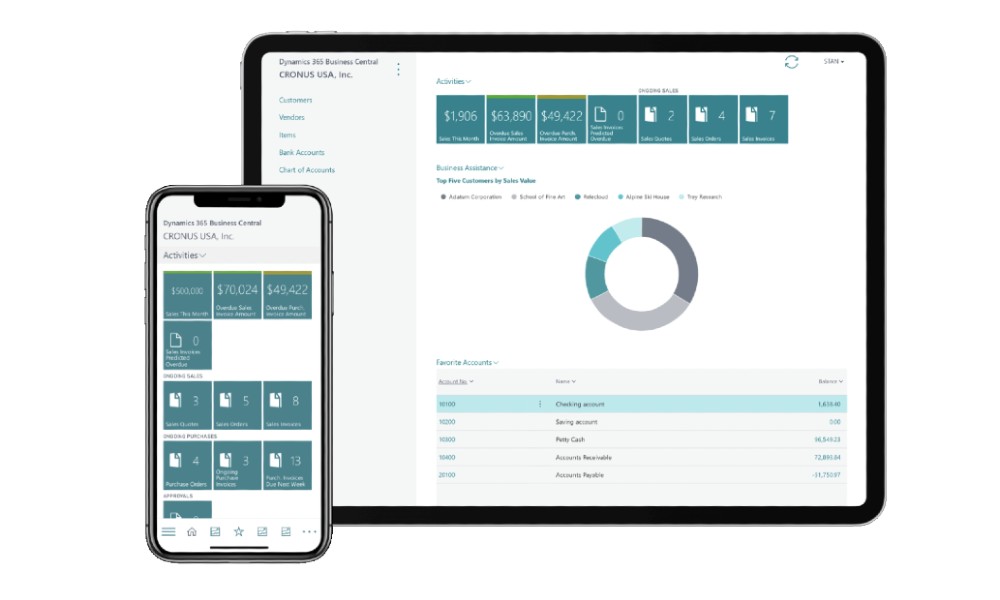The History of Microsoft Dynamics NAV to Microsoft Dynamics 365 Business Central
Microsoft Dynamics 365 Business Central is one of the most popular ERP systems used by companies worldwide today, but where did it originate and how did it come to be the robust product we know today? Let’s dive into the history of Microsoft Dynamics NAV and its ultimate evolution to become the Microsoft Dynamics 365 Business Central ERP many companies continue to use today.
The Timeline of Microsoft Dynamics NAV to Dynamics 365 Business Central
The Founding of Personal Computing and Consulting (PC&C)
1983
Three Danish college students, Jesper Balser, Torben Wind and Peter Bang, start Personal Computing and Consulting (PC&C). (Trivia side note – Peter Bang’s grandfather was the Bang in Bang Olufsen, the audio equipment company)
1985
PC Plus, PC&C’s first accounting package and single-user application with basic functionality, was released.
1987
Three years after the release of PC Plus followed the first version of Navision, called Navigator, an accounting application that allowed users to access the system simultaneously.
The Navision Era
1990
This year was a big milestone, as Navision 3.0 began to be distributed in other European countries. This version of Navision added a development environment and provided the ability to modify logic and objects, ultimately giving Navision the reputation of being a solution that was tailorable and could meet custom business processing needs. The solution was considered very advanced and forward thinking for its time.
1992
An agreement between PC&C and Peachtree Software brought Navigator to the United States, which made Navision a worldwide product at that stage.
1995
PC&C was renamed to Navision Software. The first version of Navision based on Microsoft Windows 95, Navision Financials 1.0, was released.
Microsoft’s Acquisition of Navision
2002
Microsoft bought Navision after previously acquiring Great Plains Software. Navision became a new division at Microsoft.
2005
Microsoft rebranded Navision and released it as Microsoft Dynamics NAV.
The Launch of Microsoft Dynamics NAV
2008
Microsoft launched Dynamics NAV 2009, which contained both the classic client and a tailored three-tiered architecture, as well as Pages and Visual Studio.
2015
Dynamics NAV was able to be integrated with Office 365 applications.
2016
Integrations with Power BI and universal app workflows were introduced.
2017
Integrations with Cortana design mode and the web client were introduced.
Between 2013 to 2017 was an important time as the pace of technological change was faster than ever. More and more features were introduced every year, including the SharePoint client, web client, and unicode.
The Release of Dynamics 365 Business Central
2018
This was another major milestone as Dynamics 365 Business Central cloud was released. This caused a paradigm shift, even for traditional Microsoft Partners that were used to implementing and customizing NAV.
With the introduction of Dynamics 365 Business Central cloud, mindsets shifted to extending ERPs with pre-built solutions built by credible software developers partnering with Microsoft.
The End of Mainstream Support for NAV
Fast forward to the beginning of 2023, where mainstream support for NAV 2018 has officially ended, but extended support remains. What this means is that there are no new features released, no non-security updates, no bug fixes, and no technology updates.
For Dynamics 365 Business Central on-premises users, updates must be made every 6 months to continue receiving mainstream support, whereas with Business Central online, all updates are done seamlessly behind the scenes.
Dynamics 365 Business Central On-Premises vs. Online
Not only is Dynamics 365 Business Central online a superior product to Business Central on-premises, but it also helped shift the paradigm to drive organizations towards a solution that is very easily accessible and available for staff to use from anywhere. Most solutions now are cloud-focused and there are very few remaining solutions tailored to on-premises customers.
With each new version released, Business Central on-premises and online become more and more distinct. Business Central online is considered the superior product as it allows for interoperability with Microsoft 365, integrates with Microsoft Teams and SharePoint, and Power BI reporting dashboards and analytics are embedded within the platform. With Business central on-premises, Power BI reports cannot be configured or deployed, workflows cannot be created in Power Automate, and there is no Microsoft Teams integration, among many other limitations.
Ultimately, it’s all about harmonizing your existing investments with Microsoft and having your applications work together seamlessly, which is why we strongly believe Dynamics 365 Business Central online is the ERP that organizations should be aiming to use today.
Migrate to Dynamics 365 Business Central with Ease
Depending on your organization, there are a few different types of migrations available to you. Now that mainstream support for Dynamics NAV has ended, the experts at EFOQUS can help you make the migration to Dynamics 365 Business Central online so you can leverage customizations and integrations with ease to elevate your ERP solution and improve operations within your business.
Get in touch with us today!
